People’s Perception of Experimental Installations for Sustainable Energy: The Case of IFMIF-DONES
Abstract
:1. Introduction
1.1. The International Fusion Materials Irradiation Facility—Demo-Oriented NEutron Source (IFMIF-DONES)
1.2. Perceived Psychosocial Hazards
2. Materials and Methods
- Personal data: gender, age, children, training and professional activity (5 items).
- General knowledge about IFMIF-DONES project (4 items).
- Specific knowledge about energy and nuclear facilities (6 items).
- Socio-economic aspects of the project (12 items).
- Perceived Safety (6 items).
- Information about the interest and general opinion of the project (4 items).
3. Results
4. Discussion
- (1)
- This facility will be a key milestone towards clean energy with almost-zero emissions.
- (2)
- It will bring better quality of life from material, cultural and social perspectives.
- (1)
- Women seem to have less fear to eventual safety problems than men. The explanation for this result needs more reflection and should be a matter of future research.
- (2)
- The higher the level of studies, the lower the concern on safety issues. This can be due to deeper knowledge on modern experimental facilities and higher trust in scientists and engineers.
- (3)
- The higher the trust in the economic fostering of IFMIF-DONES in the area, the lower the concern about risks. This trend may respond to the balance between economic needs and assumed risks, which is often strongly linked to socioeconomic status: the higher the economic necessity, the lower the fear.
Author Contributions
Funding
Acknowledgments
Conflicts of Interest
Appendix A
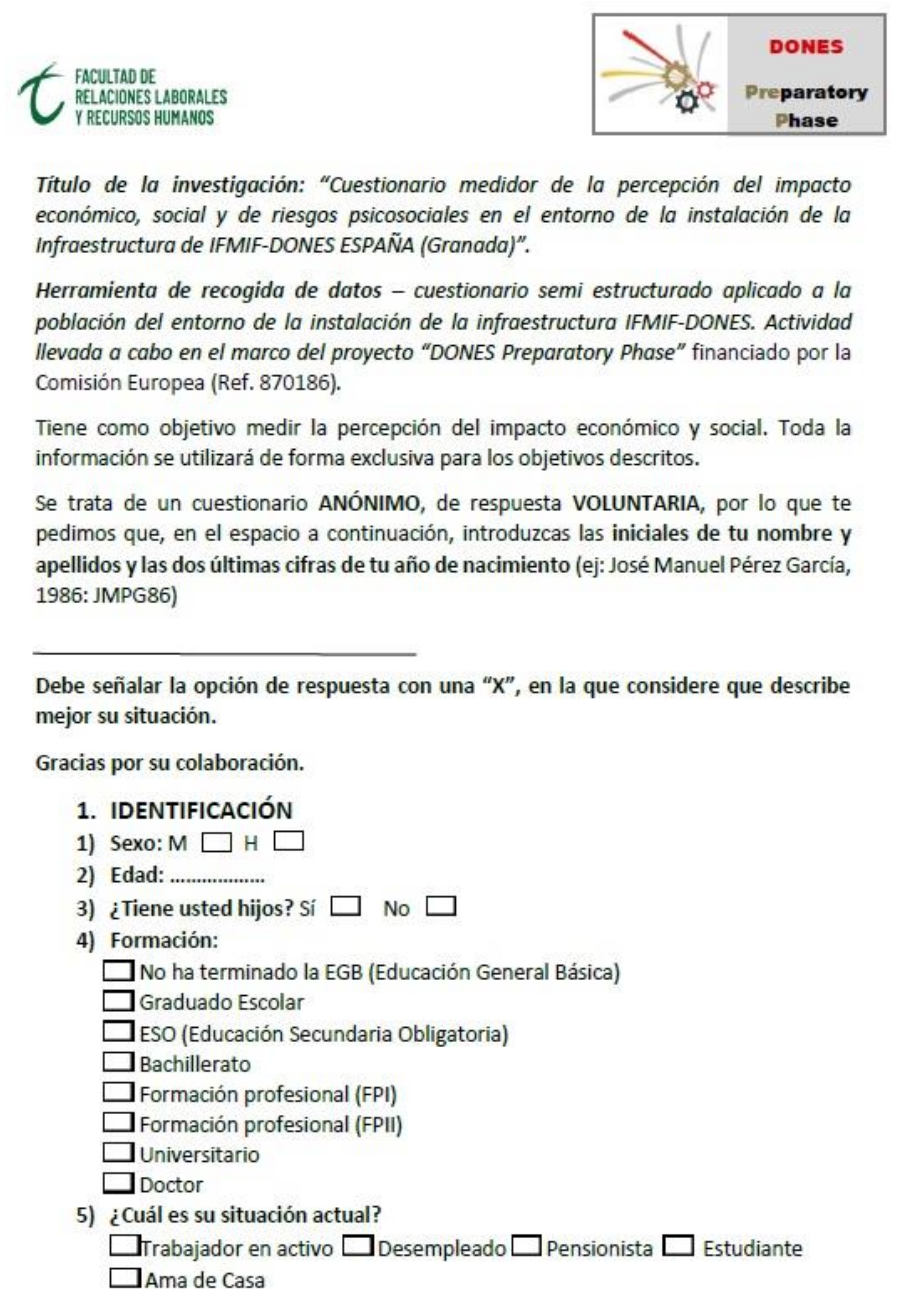
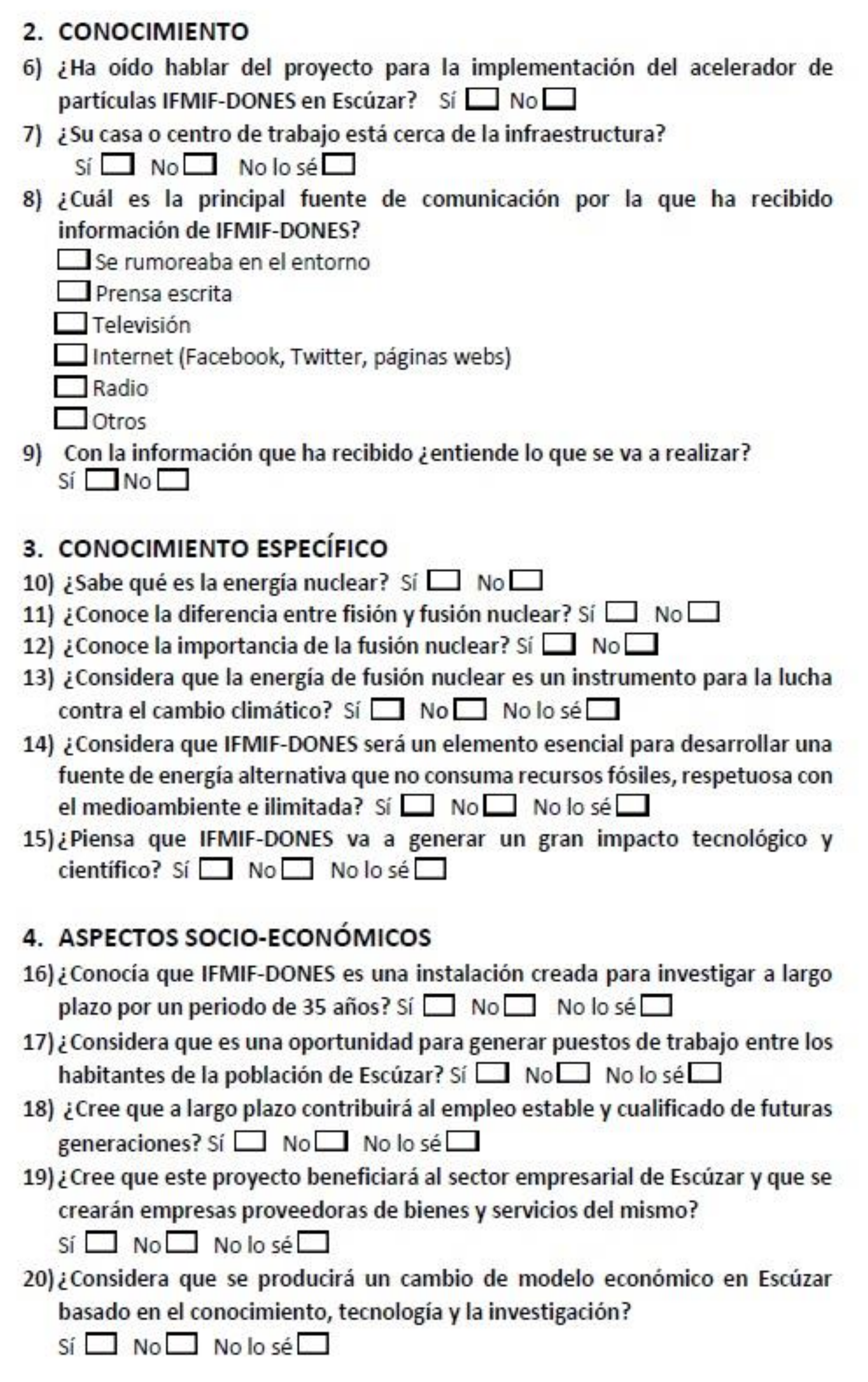
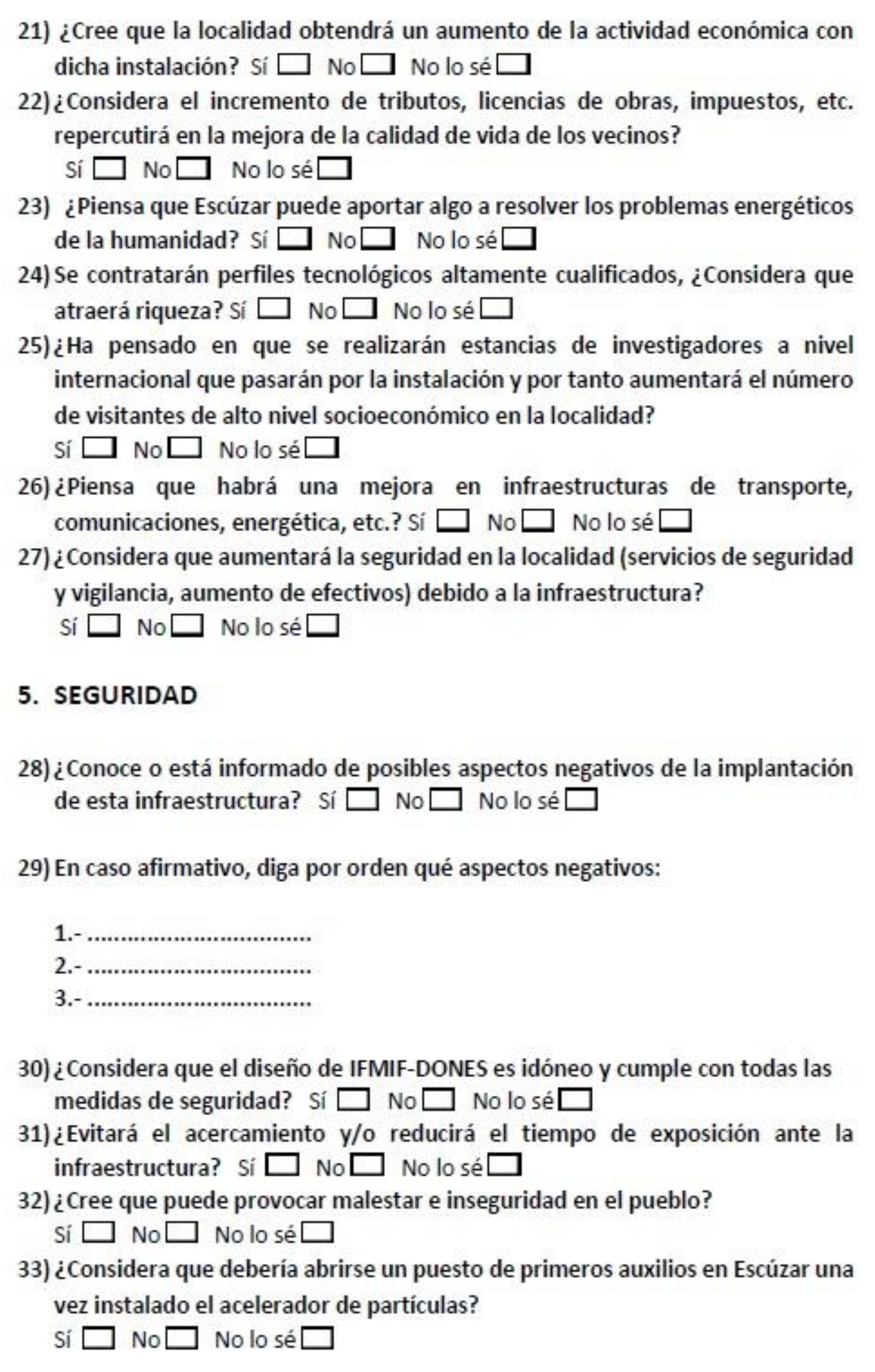
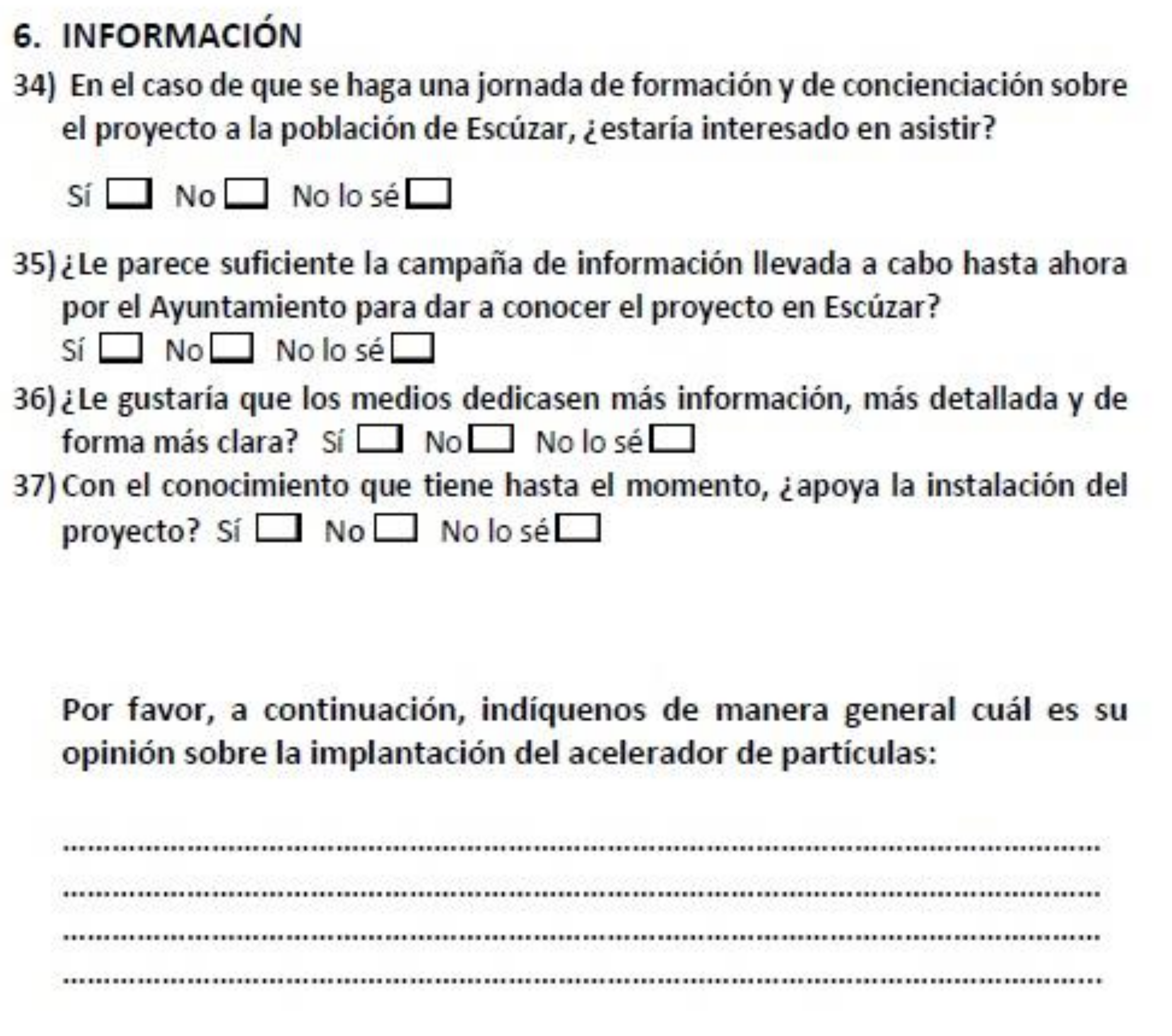
References
- World Commission on Environment and Development. Our Common Future; Oxford University Press: Oxford, UK, 1987. [Google Scholar]
- Lund, H. Renewable energy strategies for sustainable development. Energy 2007, 32, 912–919. [Google Scholar] [CrossRef] [Green Version]
- Abousahl, S.; Carbol, P.; Farrar, B.; Gerbelova, H.; Konings, R.; Lubomirova, K.; Martin Ramos, M.; Matuzas, V.; Nilsson, K.; Peerani, P. Technical Assessment of Nuclear Energy with Respect to the ‘Do No Significant Harm’ Criteria of Regulation (EU) 2020/852 (‘Taxonomy Regulation’); EUR 30777 EN; Publications Office of the European Union: Luxembourg, 2021; ISBN 9789276405382. [Google Scholar] [CrossRef]
- International Thermonuclear Experimental Reactor (ITER) website. Available online: https://www.iter.org/ (accessed on 21 October 2021).
- Fernández-Pérez, V.; Peña-García, A. The Contribution of Peripheral Large Scientific Infrastructures to Sustainable Development from a Global and Territorial Perspective: The Case of IFMIF-DONES. Sustainability 2021, 13, 454. [Google Scholar] [CrossRef]
- Esteban-López, R.; Troya, Z.; Fernández-Pérez, V.; Peña-García, A. The contribution of experimental energy facilities to the achievement of SDG in their environment: The case of IFMIF-DONES. In Proceedings of the 19th International Conference on Renewable Energies and Power Quality (ICREPQ’21), Almeria, Spain, 28–30 July 2021. [Google Scholar]
- Nguyen, T.P.L.; Peña-García, A. Users’ Awareness, Attitudes, and Perceptions of Health Risks Associated with Excessive Lighting in Night Markets: Policy Implications for Sustainable Development. Sustainability 2019, 11, 6091. [Google Scholar] [CrossRef] [Green Version]
- Joint European Torus (JET) Website. Available online: https://www.euro-fusion.org/devices/jet/ (accessed on 21 October 2021).
- IFMIF-DONES website. Available online: https://ifmifdones.org (accessed on 21 October 2021).
- Królas, W.; Ibarra, A.; Arbeiter, F.; Bernardi, D.; Cappelli, M.; Castellanos, J.; Dezsi, T.; Dzitko, H.; Favuzza, P.; Garcia, A.; et al. The IFMIF-DONES fusion oriented neutron source: Evolution of the design. Nuclear Fusion 2021, 61, 125002. [Google Scholar] [CrossRef]
- European Union. Agreement between the European Atomic Energy Community and the Government of Japan for the Joint Implementation of the Broader Approach Activities in the Field of Fusion Energy Research. Off. J. Eur. Union. 2007. Available online: https://eur-lex.europa.eu/legal-content/EN/TXT/PDF/?uri=CELEX:22007A0921(01)&from=EN (accessed on 3 December 2021).
- European Commission website/European Regional Development Fund. Available online: https://ec.europa.eu/regional_policy/en/funding/erdf (accessed on 21 October 2021).
- EUROfusion website. Available online: https://www.euro-fusion.org (accessed on 21 October 2021).
- Esteban, R.; Troya, Z.; Herrera-Viedma, E.; Peña-García, A. IFMIF-DONES as paradigm of institutional funding in the way towards sustainable energy. Sustainability 2021, 13, 13093. [Google Scholar] [CrossRef]
- International Labour Office (ILO). Available online: https://www.ilo.org/global/lang--en/index.htm (accessed on 21 October 2021).
- International Labour Office (ILO). Psychosocial Factors at Work: Recognition and Control; International Labour Office: Geneva, Switzerland, 1984; Available online: https://www.who.int/occupational_health/publications/ILO_WHO_1984_report_of_the_joint_committee.pdf (accessed on 3 December 2021).
- Kalimo, R.; El Batawi, M.A.; Cooper, C.L. Psychosocial Factors at Work and their Relation to Health; WHO: Geneva, Switzerland, 1988. [Google Scholar]
- Peña-García, A.; Hurtado, A.; Aguilar-Luzón, M.C. Impact of public lighting on pedestrians’ perception of safety and well-being. Saf. Sci. 2015, 78, 142–148. [Google Scholar] [CrossRef]
- Peña-García, A.; Hurtado, A.; Aguilar-Luzón, M.C. Considerations about the impact of public lighting on pedestrians’ perception of safety and well-being. Saf. Sci. 2016, 89, 315–318. [Google Scholar] [CrossRef]
- Peña-García, A.; Nguyen, T.P.L. A global perspective for sustainable highway tunnel lighting regulations: Greater road safety with a lower environmental impact. Int. J. Environ. Res. Public Health 2018, 15, 2658. [Google Scholar] [CrossRef] [PubMed] [Green Version]
- Qin, P.; Wang, M.; Chen, Z.; Yan, G.; Yan, T.; Han, C.; Bao, Y.; Wang, X. Characteristics of driver fatigue and fatigue-relieving effect of special light belt in extra-long highway tunnel: A real-road driving study. Tunn. Undergr. Space Technol. 2021, 114, 103990. [Google Scholar] [CrossRef]
- Slovic, P.; Flynn, J.H.; Layman, M. Perceived risk, trust, and the politics of nuclear waste. Science 1991, 254, 1603–1607. [Google Scholar] [CrossRef] [PubMed] [Green Version]
- Slovic, P.; Layman, M.; Kraus, N.; Flynn, J.; Chalmers, J.; Gesell, G. Perceived Risk, Stigma, and Potential Economic Impacts of a High-Level Nuclear Waste Repository in Nevada. Risk Anal. 1991, 11, 683–696. [Google Scholar] [CrossRef] [PubMed] [Green Version]
- Kleindorfer, P.R.; Kunreuther, H.C. Chapter 11 Siting of hazardous facilities. Handbooks in Operations Research and Management Science 1994, 6, 403–440. [Google Scholar]
- Grove-White, R.; Kearnes, M.; Macnaghten, P.; Wynne, B. Nuclear Futures: Assessing Public Attitudes to New Nuclear Power. Political Q. 2006, 77, 238–246. [Google Scholar] [CrossRef] [Green Version]
- Chilvers, J.; Burgess, J. Power Relations: The Politics of Risk and Procedure in Nuclear Waste Governance. Environ. Plan. A: Econ. Space 2008, 40, 1881–1900. [Google Scholar] [CrossRef]
- Pidgeon, N.F.; Lorenzoni, I.; Poortinga, W. Climate change or nuclear power—no thanks! A quantitative study of public perceptions and risk framing in Britain. Glob. Environ. Chang. 2008, 18, 69–85. [Google Scholar] [CrossRef]
- Troya, Z. Elaboration of a Questionnaire to Measure the Perceived Psychosocial Risks in the Environment of the Infrastructure IFMIF-DONES; End-of-Degree Project; University of Granada: Granada, Spain, 2021. [Google Scholar]
- Kleinbaum, D.G.; Klein, M. Logistic Regression, 3rd ed.; Springer: Berlin/Heidelberg, Germany, 2010. [Google Scholar]
- Rutherford, A. Introducing Anova and Ancova: A GLM Approach; SAGE Publications: New York, NY, USA, 2001. [Google Scholar]
- European Commission. Available online: https://ec.europa.eu/energy/eu-buildings-factsheets-topics-tree/energy-poverty_en (accessed on 3 December 2021).
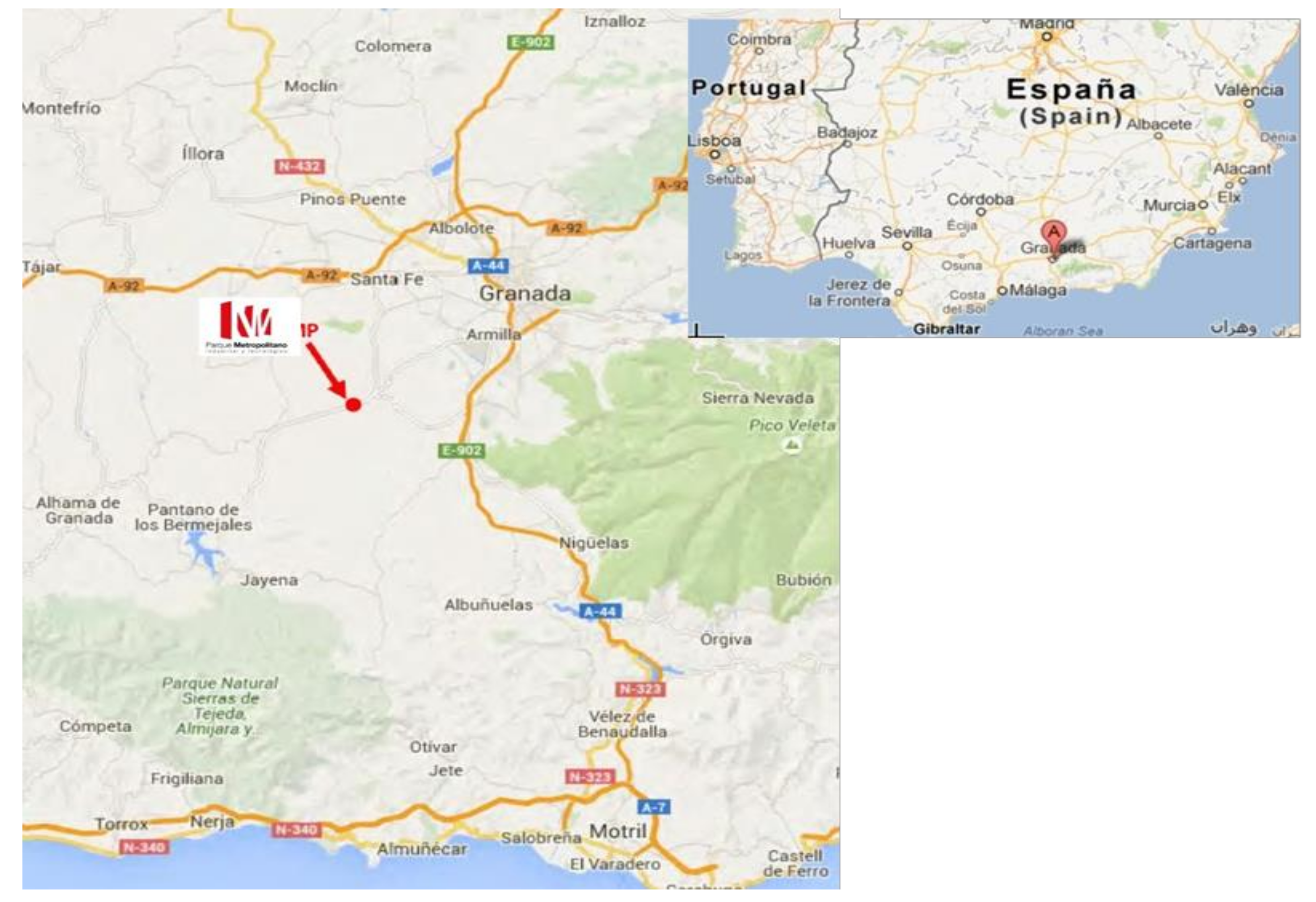
| Group | Scale | Label | Question |
|---|---|---|---|
| Previous information | Yes/No | inform1 | With the information you have, do you understand what is going to be done? |
| Yes/No | inform2 | Do you know what nuclear power is? | |
| Yes/No | inform3 | Do you know the difference between nuclear fission and fusion? | |
| Yes/No | inform4 | Do you know about the importance of nuclear fusion? | |
| General impact of the infrastructure | 3-point | impact1 | Do you think that the fusion energy is a tools against the climate change? |
| 3-point | impact2 | Do you think that IFMIF-DONES will be a key element to develop an alternative source of energy that does not consume fossil resources, environmentally friendly and unlimited? | |
| 3-point | impact3 | Do you think that IFMIF-DONES will have a great technological and scientific impact? | |
| 3-point | impact4 | Did you know that IFMIF-DONES is designed to investigate at long term about 35 years? | |
| 3-point | impact5 | Do you think that Escúzar can contribute to solve the energy problems of Mankind? | |
| Economic impact | 3-point | econ1 | Do you think it is an opportunity to create jobs for Escúzar inhabitants? |
| 3-point | econ2 | Do you think that it will contribute to stable and qualified employment for future generations? | |
| 3-point | econ3 | Do you think that this project will benefit the business sector of Escúzar and that new companies to supply goods and services will be created? | |
| 3-point | econ4 | Do you think that there will be a change in the economic model of Escúzar based on knowledge, technology and research? | |
| 3-point | econ5 | Do you think that the town will increase its economic activity with this infrastructure? | |
| 3-point | econ6 | Do you think that the increase in incomes from taxes, licenses and other will improve the quality of life of the inhabitants? | |
| 3-point | econ7 | High qualified technical profiles will be hired. Do you think that it will generate incomes? | |
| 3-point | econ8 | Have you thought that there will be stays of international researchers visiting the facility and thus the number of visitors with high socioeconomic level in the town will increase? | |
| 3-point | econ9 | Do you foresee an improvement in the communication, transport and energy infrastructures? | |
| 3-point | econ10 | Do you think that the security in the town will increase (security services, more policemen) thanks to the infrastructure? | |
| Safety of infrastructure | 3-point | segur1 | Do you think that the design of IFMIF-DONES is accurate and fulfills all the safety measures? |
| 3-point | segur2 | Will you avoid to get near the facility and/or decrease the time of exposure there? | |
| 3-point | segur3 | Do you think it can cause discomfort and lack of safety in the town? | |
| 3-point | segur4 | Do you think that a first aid station should be open in Escúzar once the facility is built? | |
| Training neccesity | 3-point | formac1 | If a training session directed to the inhabitants of Escúzar were celebratedwould you attend? |
| 3-point | formac2 | Do you think that the information campaign carried out by the Town Hall to explain the project up to date is enough? | |
| 3-point | formac3 | Would you like that the media devoted more, more detailed and clearer information? |
| 2020 Census | Survey | |
|---|---|---|
| Female | 381 (48%) | 173 (56%) |
| Male | 410 (52%) | 138 (44%) |
| Age | ||
| 20 < Age < 65 | 488 (75%) | 277 (92%) |
| Age > 65 | 163 (25%) | 24 (8%) |
| Studies | ||
| No studies or basic | - | 136 |
| High school | - | 81 |
| University | - | 94 |
| Source | ||
| It is said (rumors) | 142 | |
| Press | 44 | |
| TV | 53 | |
| Internet & Social Net. | 53 | |
| Radio | 4 | |
| Other | 15 | |
| Average | SD | Error | Sig | |
|---|---|---|---|---|
| Information | 0.6389 | 2.7381 | 0.1863 | 0.257 |
| Impact | 2.1806 | 1.8375 | 0.1250 | 0.464 |
| Economy | 6.8426 | 4.0374 | 0.2747 | 0.712 |
| Perceived Safety | −0.0926 | 1.6874 | 0.1148 | 0.505 |
| Formation | 1.6157 | 1.2145 | 0.0826 | 0.927 |
| Factors | Squares Sum | Average Square | F | p |
|---|---|---|---|---|
| Gender | 12.93 | 12.927 | 5.889 | 0.016 |
| Impact | 85.14 | 85.143 | 38.788 | <0.001 |
| Economy | 37.81 | 37.814 | 17.227 | <0.001 |
| Residuals | 1097.53 | 2.195 |
Publisher’s Note: MDPI stays neutral with regard to jurisdictional claims in published maps and institutional affiliations. |
© 2022 by the authors. Licensee MDPI, Basel, Switzerland. This article is an open access article distributed under the terms and conditions of the Creative Commons Attribution (CC BY) license (https://creativecommons.org/licenses/by/4.0/).
Share and Cite
Troya, Z.; Esteban, R.; Herrera-Viedma, E.; Peña-García, A. People’s Perception of Experimental Installations for Sustainable Energy: The Case of IFMIF-DONES. Sustainability 2022, 14, 899. https://doi.org/10.3390/su14020899
Troya Z, Esteban R, Herrera-Viedma E, Peña-García A. People’s Perception of Experimental Installations for Sustainable Energy: The Case of IFMIF-DONES. Sustainability. 2022; 14(2):899. https://doi.org/10.3390/su14020899
Chicago/Turabian StyleTroya, Zaida, Rafael Esteban, Enrique Herrera-Viedma, and Antonio Peña-García. 2022. "People’s Perception of Experimental Installations for Sustainable Energy: The Case of IFMIF-DONES" Sustainability 14, no. 2: 899. https://doi.org/10.3390/su14020899
APA StyleTroya, Z., Esteban, R., Herrera-Viedma, E., & Peña-García, A. (2022). People’s Perception of Experimental Installations for Sustainable Energy: The Case of IFMIF-DONES. Sustainability, 14(2), 899. https://doi.org/10.3390/su14020899








